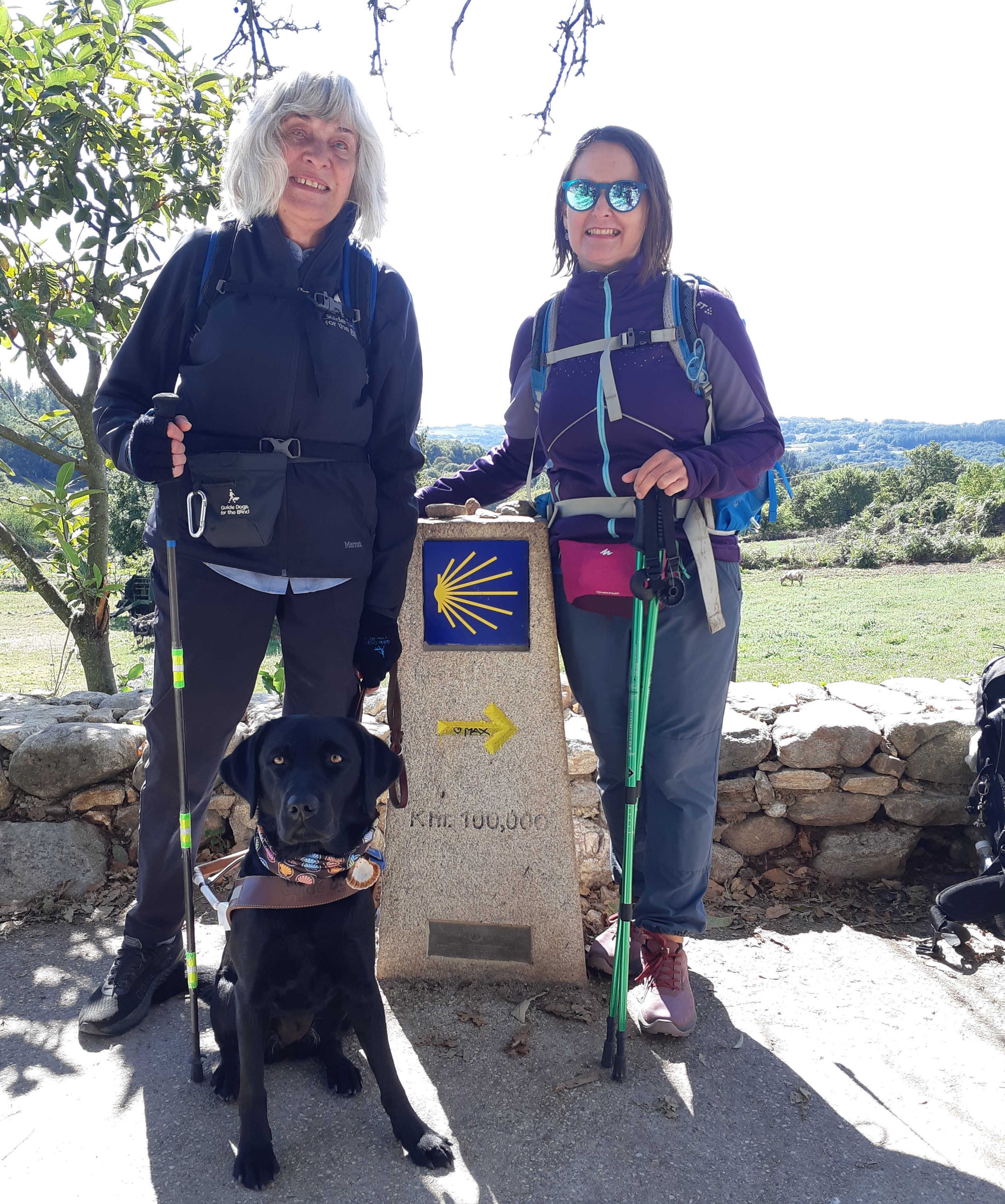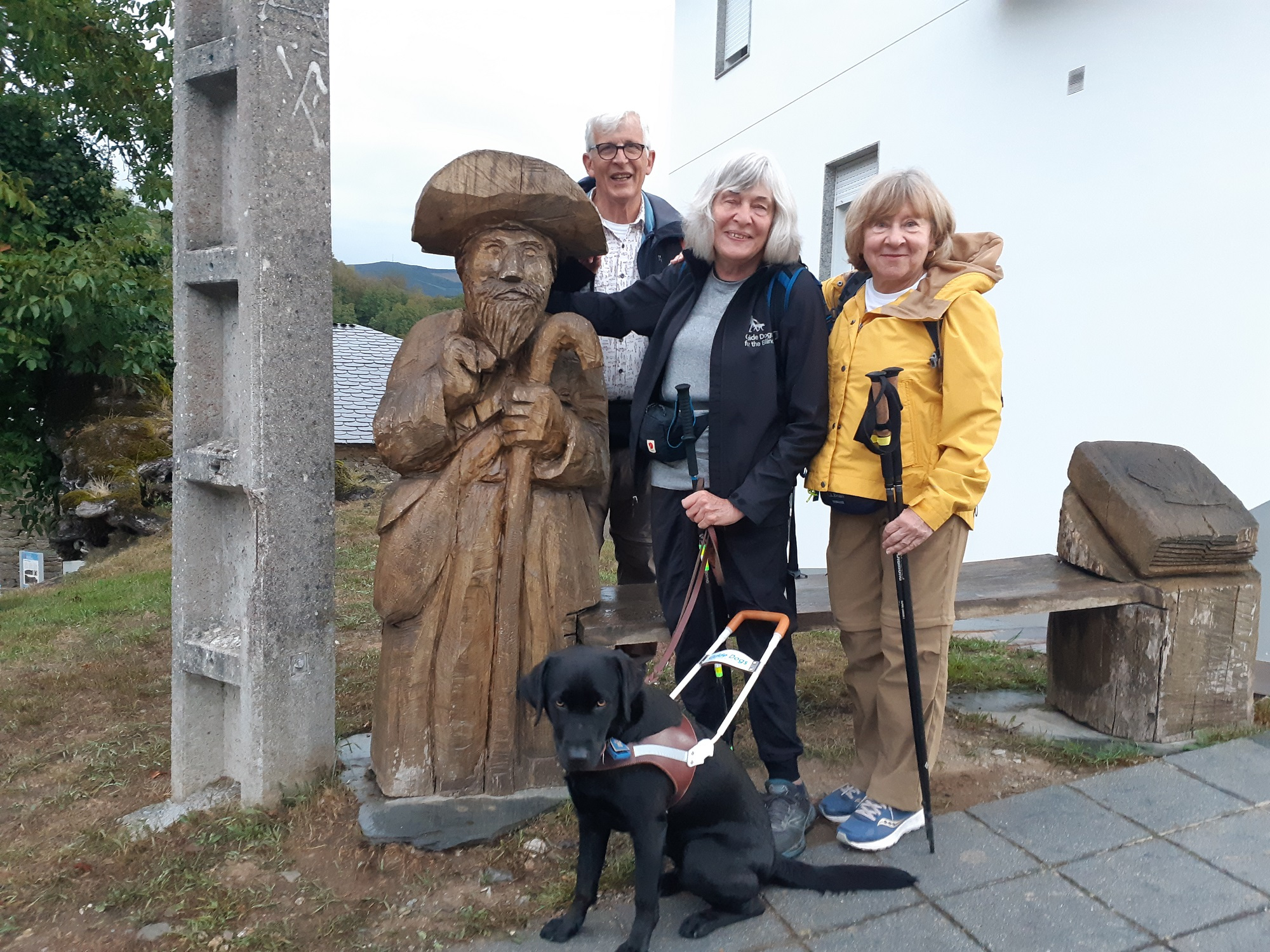Walking Spain’s Camino de Santiago was a long-held, cherished dream of GDB client and board member Joan Robinson. But it wasn’t until Joan was in her early 70s that she found the courage to embark on her transformative journey. That’s when the Reverend Susan Haig at Joan’s church in Toronto announced she would lead a Camino tour.
Joan volunteered to be on the planning committee but wasn’t sure she would be able to keep up with the others. While fit and accustomed to 3 ½ mile hikes, Joan doubted her capacity to walk 12 ½ mile days. “Mostly, I was unsure of the nitty gritty of walking this path without sight,” says Joan who prayed for the courage to live her dream.
After Susan offered to guide Joan so that she could join the group, Joan found the courage to go. “Her kindness was the push I needed,” says Joan. Realizing that Susan would be busy with her tour leader responsibilities, Joan, with the help of a Toronto Camino Walking Group, met Carla Agnesi, an experienced Camino walker, who joined her. In late February, Joan was partnered with her new GDB successor guide dog, Danielle, AKA Dani. A short time later, Joan investigated the possibility of taking Dani with her on the Camino. After receiving the green light from GDB’s Support Center and a Spanish ID card certifying Dani’s work as a guide dog, Joan was ready.
There are many reasons people walk the Camino. For Joan, it was an opportunity to embark on the adventure of a lifetime, to take a break from everyday life to gain perspective and reflect, to connect with nature, to stay present, and to challenge herself physically, mentally, and spiritually.
On September 23, 2022, Joan, Dani, Carla, and 12 other travelers (or pilgrims as the group called themselves), stepped onto the Camino. The first day the group stepped onto the Camino they came across a statue and plaque dedicated to San Roque, the patron saint of dogs. Joan says Dani was delighted to have a clear path with no traffic lights, few cross streets, and everyone heading in the same direction. “Her pleasure was infectious, and we found ourselves climbing to new heights and descending into the low valleys, joyfully greeting travelers with ‘buen Camino,’” says Joan. A guide dog on the Camino is rare and many on the journey stopped to give Dani their blessing, with a kiss on the head or a kind word. “By the end of this first day, Dani was the toast of the Camino,” says Joan.

Throughout their journey, Joan and Carla took breaks to hydrate and to ensure Dani could rest. Greg, another dog-loving member of their church group, examined Dani’s feet every evening to make sure her pads were not injured. “I felt the ever-changing Spanish ground under my feet, from the soft mush of the farmyard to the granite pebbles of a hillside, to the asphalt of an urban sidewalk. I listened to the ambient sounds of the deep valleys, the open farmland, the muffled sound of walking beside buildings and walls, the hushed cover of a forest canopy, and the rushing of water when near a stream. The scent of the pine and eucalyptus forests was entrancing.”
On several occasions, Joan says she had to push through doubt and fear of the unknown by staying in the moment and not worry about the possible dangers ahead. Often the steep descents were rock-strewn and tough to navigate. Dani would alert her by stopping if there was a change in texture on the path. One day, the group was heading down a precipitous narrow path and had to step from rock to rock. “I had to remain in the moment and not let the fear of falling take over and trust that we would all reach the bottom of this hill safely,” says Joan. Everyone took their time. When they made it to the bottom, they all cheered.
On their way to Sarria, Joan says they came upon a stream with a rough stone causeway with no handrails. There was mist in the air, so the way across would be slippery. It seemed impossible. But wet feet were safer feet so Carla, Susan, Joan, and Dani walked downstream and discovered stepping stones just beneath the water's surface. “I put my feet where Dani stepped and made it to the other side without incident. Dani walked across as if we did this every day,” remarks Joan.
In the days to come, the group crossed countless ancient bridges, clambered over obstacles, trudged along paths next to highways, and endured hours of rain and dampness. They kept each other safe and leaned on one another, especially when Joan and Dani were sporadically denied entrance to a bar or restaurant as some business owners misunderstood their legal obligation to welcome guide dogs. “When we were denied entrance or asked to leave, we often found another bar or restaurant where we were welcomed with warmth and Dani was considered just another guest,” says Joan.
One night when they were staying in a beautiful stone farmhouse in the countryside a ways off the Camino, their host saw Dani and said she would have to sleep in the garage. “My answer was a defiant and emphatic no!” recalls Joan. The man called their tour company and was told he had to accept Dani as a house guest. The next day he refused to take Dani in his car so they could get back onto the Camino. Joan, Dani, and Carla ended up taking a separate taxi. “While his rejection and lack of compassion stung, I choose to forgive this man and his failure of hospitality,” says Joan, noting that Carla, Joan, and Dani had been showered with love, grace, and generosity by people from all over the world. Joan even met a woman from Oregon who had fostered dogs for GDB. Other people who had raised service dogs for other organizations said they would volunteer again after meeting Dani.
After completing their eight-day journey, the trio went to the Pilgrim Office to receive their Compostela, or certificate of completion. Dani was given a special certificate for animals accompanying their owners on the pilgrimage. Summing up her Camino pilgrimage, Joan says: “It is life-changing. It’s transformative. It takes courage whether you can see or not because so much happens that’s unexpected and wonderful and challenging. Just going through an experience where you’re walking for hours is a pleasure and a challenge. It gives you time to think and to be moved by what you experience. It’s different for everyone.” For Joan, she practiced “radical trust” despite her fears. She practiced forgiveness when faced with discrimination, focusing instead on the many moments of “grace and love” that she experienced. “Those moments fill me with hope and give me the courage to continue to dream.”




